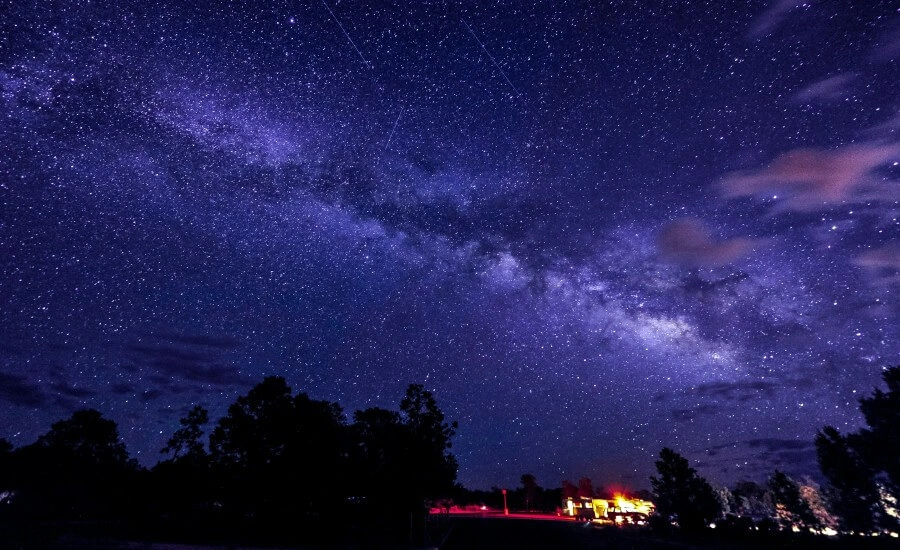
Do you remember the last time you saw a truly dark night sky? Not the washed-out, orange-tinged canvas of suburbia or the star-scarce glow above a city, but an overwhelming, ink-black dome glittering with thousands upon thousands of stars, the Milky Way arching overhead like a celestial river? For many of us, particularly the 83% of the world’s population living under light-polluted skies such a sight is a rarity, a forgotten magic. The constant glow of artificial light has drawn a veil between us and the cosmos, diminishing our sense of wonder and connection to the vast universe we inhabit.
But beyond the glare, true darkness still exists. While designated International Dark Sky Parks offer incredible protected views, there’s a special kind of magic in seeking out lesser-known, ‘hidden’ spots – places where you can experience the celestial spectacle with profound peace, solitude, and presence.
This guide is about embarking on Hidden Stargazing Hotspots: Celestial Travel at Its Finest. We’ll explore why escaping light pollution is so vital, how to mindfully connect with the cosmos, practical tips for finding your own dark sky nook, and why embracing an unplugged, tech-free approach enhances this awe-inspiring form of travel.
The Vanishing Dark: Why Seeking True Night Skies Matters

The pervasive glow of artificial light at night (ALAN), or light pollution, is more than just an aesthetic inconvenience for astronomers. It has tangible negative consequences for ecosystems and human well-being. Globally, light pollution has increased significantly, potentially by 49% or more between 1992 and 2017, and it continues to spread.
- Ecological Impact: Artificial light disrupts the natural cycles of countless species. It disorients migrating birds (leading to millions of fatal collisions annually), affects the nesting patterns of sea turtles, interferes with the mating rituals of fireflies, and alters the behavior of nocturnal predators and prey. It disrupts plant phenology, affecting pollination and seasonal cycles.
- Human Health: Our own biology is attuned to natural cycles of light and dark. Excessive exposure to artificial light at night disrupts circadian rhythms, suppresses melatonin production (a crucial hormone for sleep and health), and is linked to sleep disorders, increased stress, mood disorders, and potentially higher risks for certain diseases.
- Loss of Heritage & Connection: For millennia, the night sky was a source of navigation, storytelling, mythology, and existential contemplation across cultures. Light pollution severs this ancient connection, diminishing our sense of place in the universe and erasing a shared natural heritage. reference to history). A staggering 80% of North Americans and 60% of Europeans can no longer see the Milky Way from their homes.
Seeking out truly dark skies isn’t just about seeing more stars; it’s an act of reconnecting with a fundamental aspect of nature, reclaiming a threatened heritage, and potentially benefiting our own well-being by escaping the pervasive glow.
Beyond the Designated Parks: The Allure of Hidden Gems

International Dark Sky Parks and Reserves are invaluable treasures, offering certified dark skies and often excellent facilities. However, there’s a unique appeal to seeking out hidden stargazing hotspots – those lesser-known locations that provide exceptional views without the crowds or infrastructure.
- Solitude & Peace: Designated parks, while dark, can sometimes attract significant numbers of stargazers, especially during popular meteor showers. Finding your own secluded spot allows for a deeper sense of peace, quiet contemplation, and an undisturbed connection with the cosmos. The silence of a truly remote location at night is an experience in itself.
- Sense of Discovery & Adventure: There’s a thrill in using maps and knowledge to find your own perfect patch of darkness. It adds an element of exploration and self-reliance to the experience, making the celestial reward feel even more earned.
- Unique Perspectives: Hidden spots might offer different foregrounds or landscape contexts for viewing the stars, leading to unique photographic opportunities (if desired) or simply a different aesthetic experience compared to established viewpoints.
- Accessibility (Sometimes): While some hidden spots require significant effort to reach, others might be surprisingly accessible yet overlooked – perhaps a quiet rural road turnoff, a remote beach, or a high point just outside a smaller town’s light dome.
The quest for hidden hotspots transforms stargazing from a passive activity into an active, mindful exploration of both the landscape and the night sky.
What Makes a Stargazing Hotspot ‘Hidden’?

What elevates a simple dark spot to a potential ‘hidden hotspot’? It’s usually a combination of factors:
- Excellent Darkness (Low Bortle Scale): The Bortle Scale classifies night sky darkness from Class 1 (pristine, darkest possible) to Class 9 (inner-city sky). Hidden hotspots typically fall within Class 1 to Class 4. Class 3 or 4 might be achievable relatively close (20-50 miles) to smaller towns, offering great views including the Milky Way, while Class 1 or 2 often requires significant travel to truly remote wilderness.
- Remoteness from Light Sources: The key is distance and direction from major cities and towns. Even a location under a dark sky might have a noticeable light dome on the horizon from a distant city. Ideally, a hidden spot has minimal light domes in most directions. Mountains or large forests can help block distant light.
- Good Viewing Conditions: Altitude often helps, providing clearer, thinner air above haze and atmospheric disturbance. A wide, unobstructed view of the sky, particularly towards the south for Milky Way viewing in the Northern Hemisphere summer, is desirable. Low humidity (like in deserts) often yields clearer skies.
- Accessibility & Safety: A true ‘hotspot’ needs to be reasonably accessible and safe to reach and stay at during the night. This might involve a manageable drive down a dirt road, a short hike, or finding a safe spot to pull over. Safety considerations are paramount (see Concerns section).
- Lack of Official Designation/Infrastructure: What often makes it ‘hidden’ is that it’s not an official park viewpoint or observatory. It might be a piece of public land (like BLM land in the US), a quiet beach, or simply an unnamed hilltop known only to locals or dedicated sky-watchers.
Finding these spots requires research, map skills, and sometimes a bit of luck.
Mindful Gazing: Connecting Deeply with the Cosmos

Simply being under a dark sky is amazing, but approaching stargazing mindfully deepens the connection and enhances the sense of awe and well-being. It’s about presence, patience, and engaging your senses in the darkness.
- Allow Dark Adaptation: Your eyes need at least 20-30 minutes to fully adapt to darkness and perceive faint stars and details. Crucially, avoid looking at any white light during this time, especially phone screens – even a brief glance resets the process. Use only dim red light flashlights if needed for charts.
- Get Comfortable & Breathe: Find a comfortable position, ideally lying down on a blanket or mat to avoid neck strain. Take several slow, deep breaths, feeling the night air. Settle your body and mind.
- Engage All Senses (Beyond Sight): While sight dominates, notice other sensations. Feel the coolness or warmth of the air on your skin. Listen to the sounds of the night – crickets, wind, distant animals, or profound silence. Smell the scents of the earth, plants, or perhaps the distant campfire.
- Observe Without Judgment: Let your eyes wander the sky. Don’t feel pressured to immediately identify every constellation or object. Simply take in the vastness, the patterns, the sheer number of stars. Notice thoughts arising (“What’s that?”, “Is that a planet?”) without getting attached to them; gently return your focus to observing.
- Use Peripheral Vision: For very faint objects like distant nebulae or galaxies (visible as faint smudges in truly dark skies, especially with binoculars), look slightly away from the object. Your peripheral vision is more sensitive to faint light.
- Contemplate Scale & Time: Reflect on the fact that the light you’re seeing from stars traveled for years, centuries, even millennia to reach your eyes. Consider the immense scale of the universe and your own place within it. Allow feelings of awe and wonder to arise.
Mindful stargazing transforms the activity from simple observation into a contemplative practice, fostering inner peace and a profound sense of connection.
Finding Your Dark Sky Nook: Tips for the Celestial Explorer

Finding those elusive hidden hotspots requires some detective work and preparation.
- Use Light Pollution Maps: These are essential tools. Websites and apps like LightPollutionMap.info, Dark Site Finder, or others use satellite data to show levels of artificial skyglow. Look for areas designated with dark colors (grey, blue, green on many maps) indicating low Bortle scale numbers (aim for 4 or lower). Explore these areas virtually first.
- Scout Potential Locations (Daylight & Virtual): Use satellite imagery (like Google Maps satellite view) combined with topographic maps to identify potentially accessible spots within dark areas – clearings, hilltops, quiet roads, public land access points. A daylight visit beforehand is ideal to check terrain, safety, and actual obstructions.
- Consider Elevation & Obstructions: Higher elevations generally offer clearer views. Look for spots with wide-open horizons, away from tall trees or mountains that might block parts of the sky (unless those mountains help block city light!).
- Check Land Ownership & Regulations: Ensure the spot you choose is on public land where nighttime access/camping is permitted, or get permission if on private land. Check for fire restrictions or park closures.
- Talk to Locals & Astronomy Clubs: Local residents in rural areas or members of nearby amateur astronomy clubs often know the best unofficial dark sky spots. Engaging politely can yield great tips.
- Factor in the Moon: Plan your trip around the new moon phase for the darkest possible skies, essential for seeing faint objects like the Milky Way or meteor showers. A full moon acts like significant light pollution.
The search itself can be part of the adventure, leading you to beautiful, quiet places you might otherwise never discover.
Stargazing Unplugged: Why Less Tech Means More Cosmos

While stargazing apps are popular, embracing a more unplugged, tech-minimal approach significantly enhances the mindful stargazing experience and the quality of your observation.
Preserving Night Vision: The bright white/blue light from smartphone screens instantly ruins your dark adaptation, making it much harder to see faint stars and celestial details. Even briefly checking a notification resets the 20-30 minute adaptation process. Using only dim red light (which affects night vision less) for essential tasks like reading charts is crucial.
Enhancing Presence & Immersion: Constantly looking down at an app, identifying every object digitally, pulls your attention away from the direct, awe-inspiring experience of simply being under the vast night sky. Disconnecting allows for deeper sensory immersion and quiet contemplation.
Developing Observation Skills: Relying on analog tools like star charts or planispheres encourages active learning. You engage your brain differently when finding constellations by ‘star hopping’ (using bright stars as guides – Source 6.2) compared to simply pointing a phone. It builds a more intimate knowledge of the sky.
Appreciating Naked-Eye Wonders: In a truly dark sky, the naked eye can see thousands of stars, the Milky Way, sometimes even bright galaxies like Andromeda. Focusing on these fundamental sights without tech augmentation fosters profound appreciation.
Using Analog Tools: * Star Chart/Planisphere: A rotating star wheel showing constellations visible for your specific date and time. Essential analog tool. *
Red Light Flashlight: Preserves night vision for reading charts or finding dropped items. You can cover a regular flashlight with red cellophane. *
Binoculars: Excellent for bridging the gap between naked eye and telescope. They reveal details on the Moon, show Jupiter’s moons, resolve star clusters, and make faint galaxies/nebulae more visible. 7×50 or 10×50 are popular choices.
Journal & Sketchpad: Record observations, feelings, or sketch constellation patterns by hand for a deeper connection.
Letting go of the tech allows your eyes, mind, and soul to connect more directly and deeply with the cosmos above.
Hidden Stargazing Hotspots: Celestial Travel at Its Finest

Seeking out Hidden Stargazing Hotspots is more than just finding a dark place; it’s a form of mindful travel that combines adventure, presence, and a profound connection with the universe. It’s about consciously stepping away from the light-polluted, notification-driven world and entering a realm of cosmic silence and wonder. This journey requires preparation – understanding light pollution maps, mastering basic analog tools like star charts, prioritizing safety in remote locations, and crucially, embracing the magic of disconnecting.
Celestial Travel at Its Finest isn’t defined by luxury amenities or famous landmarks, but by the quality of darkness, the clarity of the view, and the depth of presence you bring to the experience. Finding that perfect, quiet spot under a canopy bursting with stars, far from the crowds, offers a unique sense of peace and perspective. It reminds us of our place in the grand cosmic ballet and fosters an appreciation for the natural world that extends far beyond our planet. By practicing mindful gazing and minimizing technological interference, we allow the universe to reveal its subtle wonders more fully, enriching our travels and potentially transforming our inner landscape.
Common Concerns & Solutions for Hidden Stargazing

Venturing into dark, remote places for stargazing naturally raises some concerns.
Concern 1: Safety – “Isn’t it dangerous to be in remote areas at night?”
- Solution: Safety is paramount. Go with a friend or group if possible. Inform someone of your exact location and expected return time. Scout the location in daylight to assess terrain and potential hazards. Check weather forecasts. Dress appropriately for potential temperature drops. Carry a first-aid kit, reliable flashlight (plus red light), and charged phone (for emergencies, signal permitting). Be aware of local wildlife and take appropriate precautions (noise makers, proper food storage). Ensure your vehicle is reliable.
Concern 2: “How do I actually find these ‘hidden’ dark spots?”
- Solution: Start with light pollution maps (online before your trip). Cross-reference with topographic maps and satellite views to identify accessible public lands (parks, forests, BLM land) or quiet roads away from town lights. Look for clearings or high points. Astronomy club forums or polite inquiries with locals in rural areas can yield tips. Be prepared for some trial and error.
Concern 3: “I won’t know what I’m looking at without my stargazing app!”
- Solution: Embrace analog tools! Get a planisphere (star wheel) for your latitude – easy to use and requires no screen. Buy a basic star chart book. Start by learning major, easily recognizable constellations (Ursa Major/Minor, Orion, Cassiopeia, Cygnus) and use them to ‘star hop’ to other objects. Binoculars help immensely. Enjoy the beauty even without naming everything!
Concern 4: “What if the weather is bad (clouds, rain)?”
- Solution: Check forecasts carefully before heading out. Have backup dates or locations if possible. Sometimes conditions change rapidly. If clouds roll in, practice mindful listening to the night sounds or use the time for quiet reflection or journaling inside your vehicle/tent. Accept that nature is unpredictable – it’s part of the experience.
Hidden Stargazing Expedition Checklist

Prepare for your celestial adventure with this focused checklist:
- Location Research: Identify potential dark sky spot(s) using light pollution maps, topographic maps, satellite views. Check Bortle scale.
- Access & Regulations: Confirm land ownership (public/private), check access rules, camping permissions, and crucial fire restrictions.
- Safety Plan: Inform someone of your detailed plans & ETA. Check weather forecast thoroughly. Pack first-aid kit. Note emergency contacts.
- Timing: Plan around the New Moon phase for darkest skies. Check moonrise/moonset times if observing near other phases. Note sunset/astronomical twilight times.
- Viewing Gear:
- Red light flashlight (essential!)
- Star chart or planisphere for your location/season.
- Binoculars (optional but highly recommended).
- Telescope (optional, for advanced users).
- Comfort Gear: Blanket, sleeping bag, camp chairs or mat for comfortable viewing (lying down is best). Warm layered clothing (hat, gloves, even in summer). Warm drinks in a thermos. Snacks.
- Navigation (Analog Focus): Physical map of the area, compass (especially if hiking away from vehicle).
- Vehicle Prep (If driving remote): Full gas tank, checked tire pressure/spare, basic tool kit, jumper cables.
- Leave No Trace Supplies: Trash bags (pack everything out!). Trowel if dispersed camping overnight.
- Mindset: Intention for presence, awe, patience. Readiness to disconnect from devices.
Look Up and Reconnect

In our brightly lit, fast-paced world, the simple act of looking up at a truly dark night sky can feel like a revolutionary act. Seeking out hidden stargazing hotspots takes us away from the familiar glow, inviting us into a space of profound quiet, vastness, and wonder. It’s a journey that encourages mindful presence, rewards patience, and connects us to the cosmos in a way that screens never can. By embracing the darkness, disconnecting from digital distractions, and using simple analog tools, we allow ourselves to fully receive the breathtaking beauty of the universe.
You now have the tools and understanding to embark on your own celestial explorations off the beaten path. You know why finding darkness matters, what makes a spot special, how to gaze mindfully, practical tips for finding locations, and the immense value of an unplugged approach. Remember to prioritize safety, respect the environment following Leave No Trace principles, and approach the night sky with humility and awe.
What hidden corner of darkness will you explore next? Use the resources, plan carefully, pack your red light and star chart, leave the notifications behind, and go find your own patch of cosmic silence. Look up, breathe deep, and reconnect with the immense and beautiful universe that holds us all. The stars are waiting.
Tech-Free Activity Guide (Mindful Stargazing Activities)

Enhance your unplugged stargazing experience with these mindful, tech-free activities:
- Naked-Eye Sky Tour: Lie back comfortably and simply scan the sky slowly. Notice the brightest stars, clusters of stars, differences in star color (subtle blues, reds, yellows), patches of darkness, and the arc of the Milky Way (if visible). Let your eyes wander without needing to identify everything.
- Constellation Tracing (with Chart): Using your red light and star chart/planisphere, identify one or two prominent constellations. Trace their shapes in the sky with your eyes or finger. Read the mythology associated with them (from a book or pre-trip research).
- Mindful Listening in Darkness: Close your eyes for a few minutes (after dark adapting). Tune into the soundscape. What natural sounds can you hear (wind, insects, animals)? What distant human sounds? Notice the quality of the silence between sounds.
- Peripheral Vision Challenge: Pick a known faint object (like the Andromeda Galaxy, M31, visible as a faint smudge to the naked eye in very dark skies) or a dim star cluster. Look slightly away from it and use your peripheral vision to see if it becomes more apparent.
- Meteor Counting (During Showers): If observing during a known meteor shower, find a comfortable spot facing the radiant point (check beforehand). Simply count the number of meteors you see in a set period (e.g., 15-30 minutes). Relax your gaze and enjoy the celestial fireworks.
- Celestial Journaling/Sketching: Bring a notebook and pen (with red light). Write down observations, feelings of awe or perspective, questions that arise, or attempt simple sketches of constellation patterns or the moon.
- Shared Wonder (Quietly): If with others, share observations quietly (“Did you see that meteor?”, “I think I found Orion”). Spend time simply appreciating the shared silence and vastness together.






